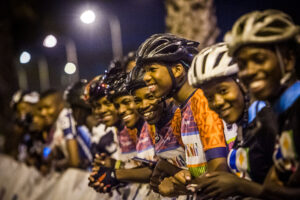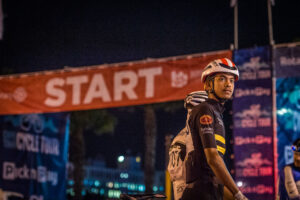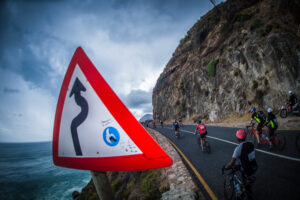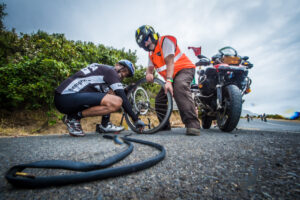Cape Town Cycle Tour – What You Need To Know
We asked a range of experts a bunch of questions: from their answers, we put together this guide to everything you wanted to know about the Cape Town Cycle Tour Tour – but were too afraid to ask.
It’s time for the Cape Town Cycle Tour – in October! Little known fact: this will be the second October Cycle Tour – the very first one was held on 28 October 1978. 43 editions later, the world’s vibiest cycle race is here again, and we’re all itching to get into our lycra. We got hold of some cycling experts, across a number of fields, and picked their brains for tips, advice, history and more to get us amped for Sunday.
DAVE BELLAIRS: EXPERT: A DIRECTOR OF THE CYCLE TOUR TRUST
What’s the one thing everyone forgets?
To pump their tyres.
What’s the most unusual thing someone has forgotten?
Someone once arrived at the start with only one shoe!
What’s the most common pre-event mistake?
Trying new things before the event – like new supplements, training gear, new diets.
What’s the most common rookie mistake?
Not spending enough time in the saddle.
What are the windiest spots along the route?
The windiest parts of the Cycle Tour are on the Foreshore, around Chapman’s Peak, and the descent of Suikerbossie. If there’s extreme weather, we urge people to become more aware on the bike and we slow them down, to make it less dangerous.
Some race-day transgressions that could get you banned?
Riding with somebody else’s number. Riders may not start or attempt to start before their designated start group. Any rider who does may be disqualified. A rider may not participate while under the influence of alcohol, or any drug or medication that prevents or might prevent a rider from properly controlling his/her bicycle. See capetowncycletour.com for the full list of rules.
Who’s been the oldest finisher?
Japie Malan, who was 93 at the 2012 event, and Mary Warner, 86 at the 2015 event.
Who is the oldest person with a sub-three?
Maurice Connor: 2:56:58 in the 2018 tour, aged 74.
Who has notched up the most sub-threes?
Linus van Onselen: 29 sub-threes in total.
What percentage of the field finishes?
95% of starters finish.
What is the breakdown in terms of finish times?
Based on the 2014 event,
a Sub-3: 1.5%
a 3 to 3.30: 9%
a 3.30 to 4: 17%
a 4 to 4.30: 17%
a 4.30 to 7: 55.5%
Has someone ever gone fastest around the course, but not been the winner (i.e. from a group behind the pros)?
– 1982
Mark Pinder had a faster time (3:01:25) than the recorded winner, Ertjies Bezuidenhout (who crossed the line first, in a time of 3:02:29).
– 1993
Wimpie van der Merwe recorded a time of 2:16 on an unconventional bike,
What shouldn’t you forget (a quick checklist)?
1. Helmet
2. RaceTec chip
3. Bicycle sticker
4. Official race number

BEN CAPOSTAGNO: EXPERT: Science to Sport Coach
I’m nervous about riding in a bunch – can you give me some tips?
Look forward! Try not to look behind you, as you could end up crashing into riders in front of you. Make sure you’re comfortable with where you’re positioned in the bunch. If you’re particularly nervous about bunch riding, rather try to ride on the side or at the back of the group. Avoid braking sharply or unnecessarily, as this could cause riders behind you to crash into the back of you. Rather, slowly reduce your speed, by freewheeling if necessary. If you need to move within the bunch, make sure other riders don’t have their wheels overlapping yours. And remember: Look forwards!
What training do I need to have done to finish?
Tricky one to answer, because it will depend on each cyclist’s background. Some people can hop on a bike on the day and be fine. Others might need at least a few rides to get through it.
I haven’t trained – should I dust the cobwebs off my bike and ride, or should I laugh it off?
I don’t think I would ever discourage anyone from riding a bike, so yeah – go for it. Just manage your expectations appropriately, and know that you may experience some discomfort on the day (and for a day or two afterwards).
What’s the best way for me to save time along the route?
Ride in a bunch, or stick with a bunch. This will conserve your energy, and help you cover ground a little quicker. If you stop at water stations, don’t hang about. Get what you need, and get going again.
I’m not interested in a good time, but I am interested in a safe time. What’s the best way to get to the finish line without any incidents?
It would be difficult to ride the world’s largest timed cycle event in isolation; so you should be comfortable with other riders around you. Pay attention, and don’t do anything silly. Look ahead of you, and don’t take any unnecessary risks on descents.
What’s the best post-race recovery drink (I’m hoping the answer is ‘beer’)?
Can’t go wrong with a chocolate milk. Get your recovery drink/meal in first, before the first cold beer. Alcohol has a negative effect on recovery.
What are the nutrition no-nos I should be aware of?
Don’t use anything new on race day. While your mate might swear by a particular product, if you haven’t used it in training before, it could cause some negative side effects for you. Don’t get fooled by the hype or claims around certain products – rather use products backed by good science.
How many bottles should I take with me?
I see little value in taking more than two bottles. If it’s particularly hot and you run out of water, just refill them at the next water station. Make sure your bottle cage is secured – dropping your bottle during the race can mess with your hydration and nutrition strategy, and become a spinning ball of terror for riders behind you.
What’s the best way to prepare in the last week before the Cycle Tour?
Keep your legs active. Don’t rest fully; rather, include a few low-intensity rides, to keep the legs awake. Throw in a few midweek ‘efforts’ of two to four minutes where you gradually increase the intensity, ending at about 8 out 10, with 10 being a maximal effort. A pre-race ride the day before is a good idea too. Nothing long or hard: one hour, with two to three two-minute efforts to get the heart rate up, will help wake the legs up for race day.
What’s the best way to handle the:
Heat
– Dress appropriately. Don’t wear extra layers that will increase your heat storage.
– Check the forecast in the days leading up to the race, and ensure your water bottles are cold (keep them in the fridge overnight).
– If there is spare water at the water stations, pour some over yourself to cool down.
Rain
– Pay attention to your speed in corners, as your handling may be affected.
– Avoid riding on painted lines and islands, as these can be very slippery with a layer of water on them.
– Ensure your drivetrain is lubricated appropriately, so you don’t suffer from chain suck.
Wind
– Bring your sense of humour.
– Stay with a bunch. This will make it a lot easier.
– Be aware of gusts on roads like Smits and Chappies.

DEVLIN EYDEN: EXPERT: Sports Scientist at High Performance Centre, Pretoria University
Do you have any last-minute advice to help me climb better?
Get climbing. Make sure you are doing sufficient hill training well before race day. Interval work also has huge benefits for strength in the legs on those nasty climbs. Ride within yourself for the majority of the race. Don’t get too caught up in the moment when the racing snakes come rumbling past you. Hold back and get into a good rhythm that works for you, and recover on the descents.
So, now that I’ve got up the hills… how do I get down them safely?
Make sure you take care when descending at high speed, as there will be slower riders on the route who may be too exhausted to pay attention to their surroundings. Ride within your limitations and skill level. Stay on the right-hand side of the road if you’re passing people, and look around you when changing direction or swinging out to pass other riders.
How much slower will I be if I ride the CTCT on a mountain bike?
Significantly slower, and your bike will be heavier and have more rolling resistance. Slick tyres would help. But if you’re more comfortable and more confident on your mountain bike as opposed to your road bike, then stick with it.
What does it take to be a contender?
Hours and hours of training and more training, with the Cycle Tour being your main goal. It’s advisable to get a structured training programme and a coach to assist you.
Gel or no gel?
Use gels only if you have trained with them and are used to them. Don’t try anything new on race day. Also, the timing of your gels is important, as you will get an energy spike from them – if you use them too early and can’t maintain energy intake, you’ll hit the wall, and suffer for the rest of the ride. Lots of water is also important when using gels.
 DR JANN KILLOPS: EXPERT: Event Race Doctor
DR JANN KILLOPS: EXPERT: Event Race Doctor
What’s it like working on the Cycle Tour?
Cape Town comes to a standstill, and it’s a celebration of everything that’s wonderful in this country.
When should a rider not participate in the Cycle Tour due to health reasons?
You should rather be a spectator if you are unwell in the week before the race, or have a medical illness that is not under control, such as uncontrolled diabetes, high blood pressure, or heart or lung disease, to name a few. You should also carefully consider withdrawing if you are carrying an injury that could result in permanent damage should you ride.
What health and safety measures are in place on Cycle Tour day?
Mediclinic provides free medical assistance from start to finish. We have 15 advanced medical care centres – 14 at the refreshment stations on the route, and one at the finish – providing full medical support, with doctors, nursing practitioners, physiotherapists and first-aid staff. Plus, a host of Covid19 strategies everywhere people might make contact with other people.
What should a cyclist do if she or he is injured during the race?
Phone 087 820 2911 for medical emergencies, or 087 820 2453 for general emergencies. Save those numbers on your phone. Please try to furnish exact details of what happened, your location, and the nearest corner (if available). If you witness an accident, please inform us too.
What are the emergencies you plan for?
Cardiac emergencies, and trauma and environmental emergencies. We also plan for the small things, like cramp, blisters, chafe, and diarrhoea. These minor issues can also ruin your day.
What are some of the most common medical issues you’ll face on race day?
The most common issues are minor problems like strains, cramps, abdominal complaints, falls, dehydration and heat illness.
Any tips on how to avoid cramping?
Make sure your bike is set up correctly, maintain adequate hydration with a balanced electrolyte solution, consider your race carefully if you have a niggling injury, stop to stretch if your muscles start to complain.
If I do cramp, what can I do about it (other than cry)?
Cramping is most often related to overuse, and occurs in muscles that are working hard. If you are cycling hard and your legs cramp, then stop, stretch, and ask one of the physios to massage the affected muscle group. However, if you are experiencing cramping in more than one muscle group, it’s likely you may have a more systemic problem, such as an electrolyte abnormality. Stop, and let one of the medics evaluate you.
How important is hydration – and is there such a thing as over-hydration?
Hydration is very important, and over-hydration is definitely a serious issue. As a rough guideline, drink to thirst, drink a balanced electrolyte solution, and avoid very sugary drinks and gels. There are many refreshment stations along the route – you don’t have to stop at all of them.
What advice would you give to cyclists…
In the run-up to the race:
Be realistic about the training you‘ve done. There’s no point in pushing yourself on the day and then having an injury, or being unwell. Practise your nutrition strategy prior to race day, including your pre-race preparation, race food (not commercial high-sugar products), and recovery food. Train in all environmental conditions, and prepare yourself for heat.
On race day:
Avoid alcohol the night before the race, don’t miss breakfast, give your body two hours from your last meal to exercise. Do a gentle stretch to warm up prior to racing. Don’t forget your sunblock. If it’s raining, wear eye protection. Do not race if you are unwell. Perform a ‘neck-check’, i.e. if your illness is above the neck, you may proceed. If you feel feverish or have a headache, or your heart rate is above the rate you’re used to, stop and spectate. If your illness is below your neck, spectate, and cheer on your friends. Don’t take anti-inflammatory drugs during exercise.
And after the race:
Have a good meal to recover, and restore your fluid balance. If you’re not urinating within an hour or two of the event, or if your heart rate doesn’t recover, come to the end tent for evaluation. Avoid alcohol.

MARC CARR: EXPERT: Bike Mechanic
Should I take my bike in for a service before the Cycle Tour?
Yes, a minor service at least will be necessary, as most people doing the Cycle Tour ride literally once a year, just for this event. Also, just to make sure it’s ‘roadworthy’ and safe.
How do I do the perfect pre-race bike check?
Make sure your tyres are pumped to the correct pressure. Tyre pressure is normally stated on the sidewall of the tyre, but roughly, a road bike is around 8 bar. Take your multi-tool and check all the bolts are tight; and go for a quick spin the day before, just to make sure everything works for the race.
What basic mechanical skills do I need to know?
The most common issues that can be repaired roadside are how to join a broken chain, and how to change a tube – many people don’t know how to do this.
So, how do I do this?
The easiest way is to inflate the tube slightly, to give it some shape. By hand, fit the tube inside the tyre, and work it around so it’s completely inside the tyre. Try to fit the tyre without tyre levers as far as you can. The last bit is always a struggle; but if you’ve made sure the tyre is seated all the way around, that should make life easier. If it’s too tight, use a tyre lever for the final section of the tyre that needs to hook onto the rim. Be very careful not to pinch the tube with the tyre lever!
What are the essential tools I need to take with me?
Multi-tool, chain breaker, paper money (can be used as a gaiter for your tyre if it gets cut), tyre levers, and a pump.
THE BICYCLING TEAM
I hear there are some Cycle Tour ‘institutions’ along the route – who (and what) should I look out for?
The route is lined with cheering fans, but look out for the guy who rings a cowbell – and the women who lift their tops at the bottom of Chapman’s Peak, which makes Chappies go by in, um, a flash. Also, you can’t miss the ladies in pink, who are raising awareness for the fight against breast cancer, stationed at the bottom of Suikerbossie – their energy gets you to the top of the hill before you can say “Cramps Bay”.
Sunglasses or no sunglasses?
Definitely sunglasses. Not only will they keep the sun out of your eyes, they will also mask your pain when you climb the hills. Please note that the arms of your sunglasses must always be placed over your helmet straps. No exceptions. It’s just the way it is.
Should I shave my legs?
Definitely maybe. It depends on your reasons. If you’re doing it to go faster, then no. A 1987 study concluded that the aerodynamic improvement due to shaved legs is roughly 0.6 per cent, which could result in a savings of around 5 seconds in a 40km time trial ridden at 37km/h. How much saving for an amateur? About a quarter of a third of an eleventy-millionth of a second. However, looking down and seeing shaved guns will make you think you’re a pro, which might actually make you go faster. Most pros ride with shaved pins because hairy-legged massages hurt like hell. But the real reason not to shave your legs is so that you can feel smug when you cruise past shaved riders. Besides, if Peter Sagan can sport hairy legs in the peloton, you can too.
I’m more than a little embarrassed by the bulge that comes with wearing tight Lycra – can I wear baggies?
While many mountain bikers are turning their back on Lycra, wearing baggies on a road bike is one of cycling’s most serious fashion crimes. Don’t run away from the moose knuckle – own it; just stay out of view of small children and the easily offended, who may be scarred for life.
Okay, okay. I’ll wear bib shorts. But can I wear undies underneath?
Certainly not. It’s commando, or don’t get on your bike. And that’s not just because of the aesthetic – it’s actually about comfort.
Should I apply bum cream? And if so, what are the rules?
Yes. Chamois cream minimises friction, and helps prevent saddle sores. Just dab and apply where body meets chamois. It will absorb quickly, so there’s no need to rub the cream in. The main rule, though, is don’t double-dip if you share bum cream with someone else.
What’s the toughest part of the Cycle Tour route?
People mutter darkly about Suikerbossie, and yes, after you’ve got 80km or so in your legs it’s a biyatch of a climb; but actually, the toughest part of the tour is the first 10km. You’ve spent a lot of nervous energy in the queue for the loo, finding your chute, and not getting squashed by wobbly riders at the start – and now you have to deal with the undulating climbs up the Blue Route.
What’s the most heartbreaking moment on the route?
When you’re riding up Chapman’s Peak and you see the summit, you look down at your splits and you see you’re ahead of schedule, and your spirits soar. But then you realise you’re not at the top – it’s a false summit that looks exactly like the real thing. And that’s when your heart breaks. No matter how many times a rider has climbed Chappies, they always get caught by the CFS (Chappies False Summit).
When is boasting about your Cycle Tour acceptable?
When you’ve reached one of these three Cycle Tour milestones: you’ve completed your first one; or your 21st one; or you’ve won.
For how long is it acceptable for me to wear my finisher’s medal?
For no longer than the time you spent on the saddle.
Should I care about who wins?
Yes, the tour is one of the most prestigious bike races in the world, with a veritable Who’s Who of celebs and pros taking part. The winner is a big deal in the cycling world – and you can tell your mom you raced against him.
What bodily functions are acceptable in the bunch?
Farting is fine – after all, it’s nature’s call, so just get on with it. Snot-rocketing is okay, but remember to drop to the back of the bunch so you don’t snot on someone. Weeing in your shorts should only be done if you’re on track for a personal best – and even then it’s a last resort. If you really have to pee in the saddle, unclip one foot and bend your knee, so the pee will flow off your knee instead of running into your shoe.
What’s the deal with people shouting “Hold your line”? I mean, we’re cycling, not fishing.
It’s a warning to cyclists who wobble dangerously all over the place to ride in a straight line, to avoid taking the peloton down with them.
Should I put it on Strava?
Of course. After all, if it’s not on Strava, it never happened.
READ MORE ON: Cape Town Cycle Tour featured races

